Welcome to your new favorite breakfast companion! This English Muffin Bread recipe transforms your kitchen into an artisan bakery with minimal effort and maximum flavor. As someone who's spent countless mornings perfecting the art of sourdough baking, I can confidently say this English Muffin Bread recipe delivers that coveted nooks-and-crannies texture we all crave.
What makes this English Muffin Bread recipe truly special is its forgiving nature and incredible versatility. Whether you're a sourdough beginner or seasoned baker, this Sourdough English Muffin Bread recipe produces consistent, bakery-quality results every single time. The tangy sourdough flavor paired with the classic English muffin texture creates the perfect foundation for your morning toast, sandwiches, or even French toast adventures.
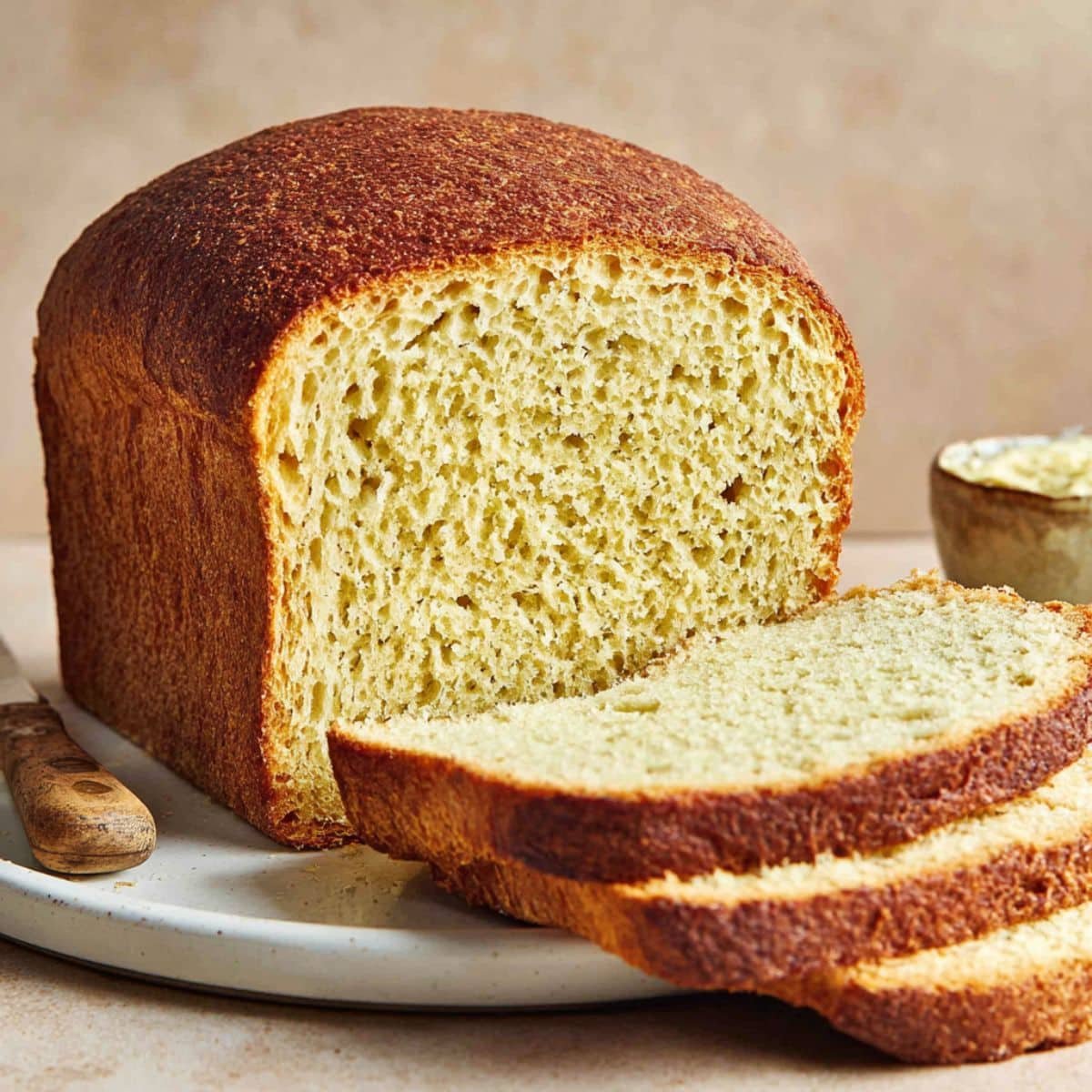
The Ancient Art Meets Modern Convenience
Sourdough English muffin bread represents the beautiful marriage between traditional fermentation techniques and contemporary baking convenience. This English Muffin Bread recipe draws inspiration from centuries-old sourdough practices while embracing the practicality modern home bakers need. The wild yeasts in your sourdough starter work their magic overnight, developing complex flavors that commercial yeasts simply cannot replicate.
What sets this English Muffin Bread recipe apart from regular English muffin recipes is the depth of flavor and improved digestibility that fermentation provides. The long, slow rise breaks down gluten proteins and phytic acid, making this English Muffin Bread recipe not only more delicious but potentially easier on your digestive system. Plus, the natural preservation qualities of sourdough mean your homemade loaf stays fresh longer than conventional bread.
Jump to:
Ingredients
- Active sourdough starter
- Bread flour
- Warm water
- Salt
- Cornmeal for dusting
- Honey or sugar
- Olive oil
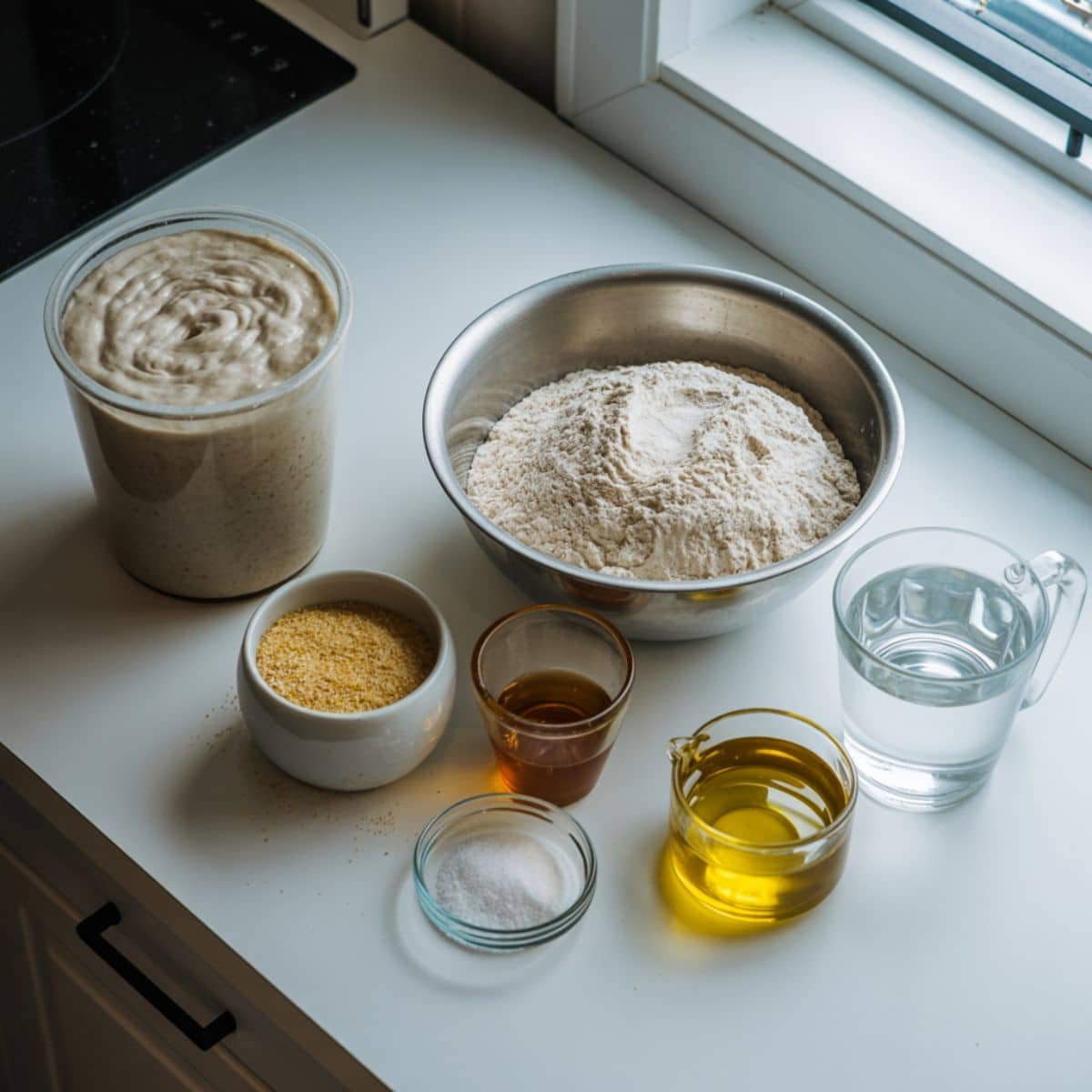
See recipe card for quantities.
Instructions
Prepare the Dough Foundation
- Mix your active sourdough starter with warm water in a large bowl until well combined
- Add honey and stir until dissolved completely
- Gradually incorporate the bread flour and salt, mixing until a shaggy dough forms
- Don't worry about smooth texture; the sticky, rough appearance creates those coveted English muffin holes and pockets
First Rise and Development
- Cover your bowl with a damp kitchen towel
- Let the dough rise at room temperature for 8-12 hours, or overnight
- Allow wild yeasts and bacteria in your sourdough starter to develop flavor complexity
- Watch for the dough to nearly double in size and develop a slightly domed surface with visible bubbles
Shape and Final Rise
- Generously dust a loaf pan with cornmeal to prevent sticking and add authentic texture
- Gently deflate the risen dough and shape it into a log that fits your prepared pan
- Dust the top with additional cornmeal and cover loosely
- Allow a final 2-3 hour rise until the dough crowns above the pan rim
- Bake in a preheated 425°F oven for 35-40 minutes until deeply golden and hollow-sounding when tapped
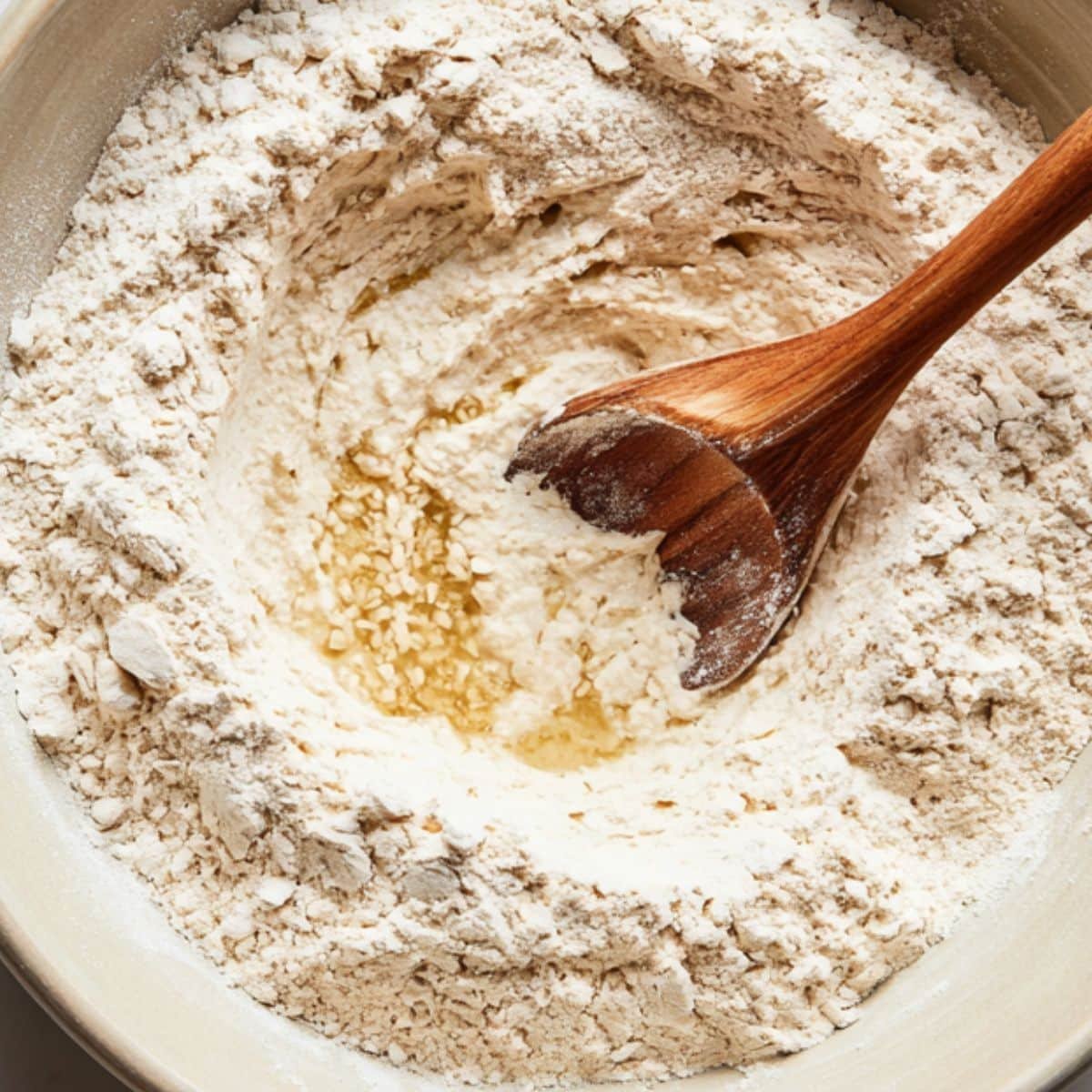
- Prepare Dough: Mixing sourdough starter, warm water, and flour in a bowl
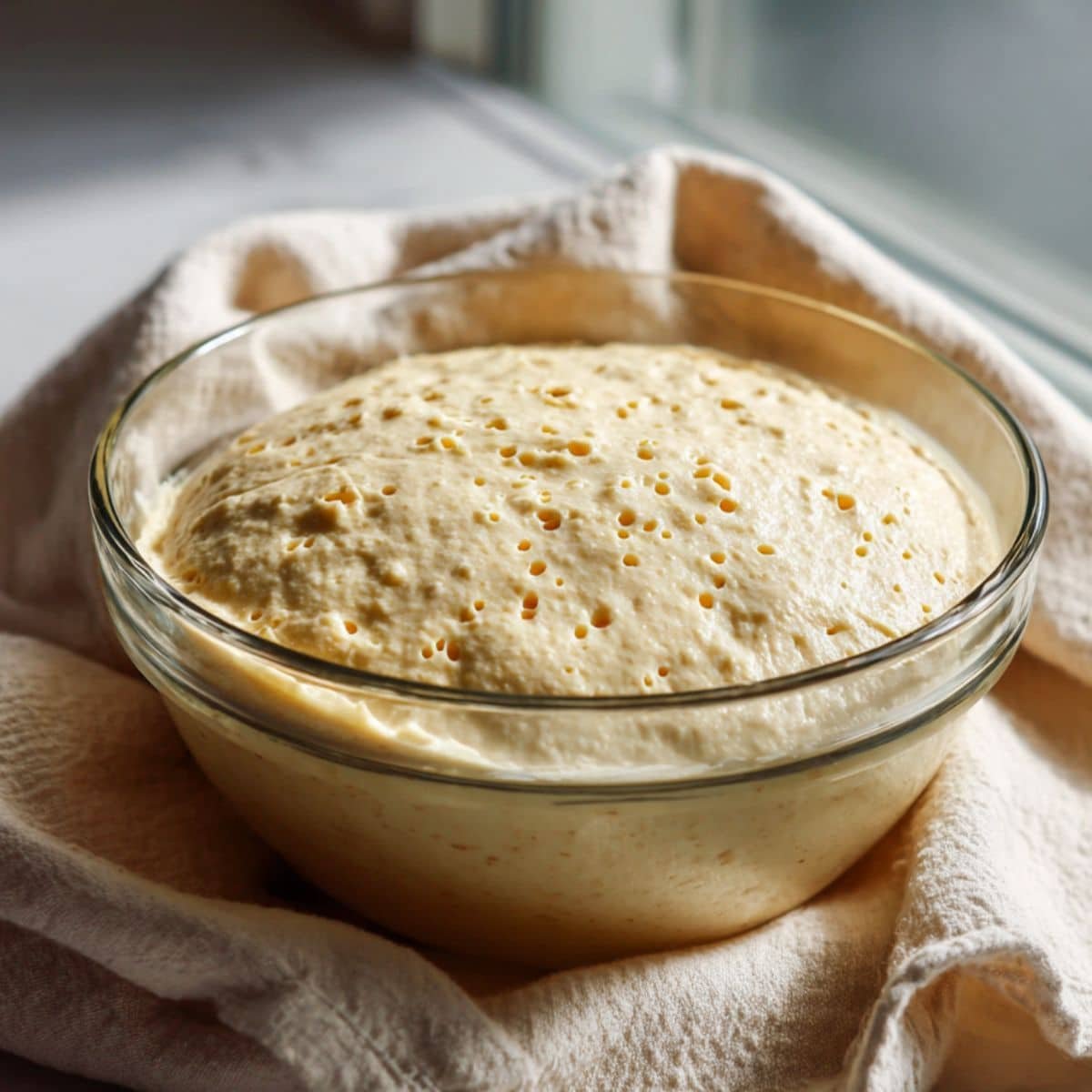
- First Rise: Bowl of bubbly dough covered with towel on white counter
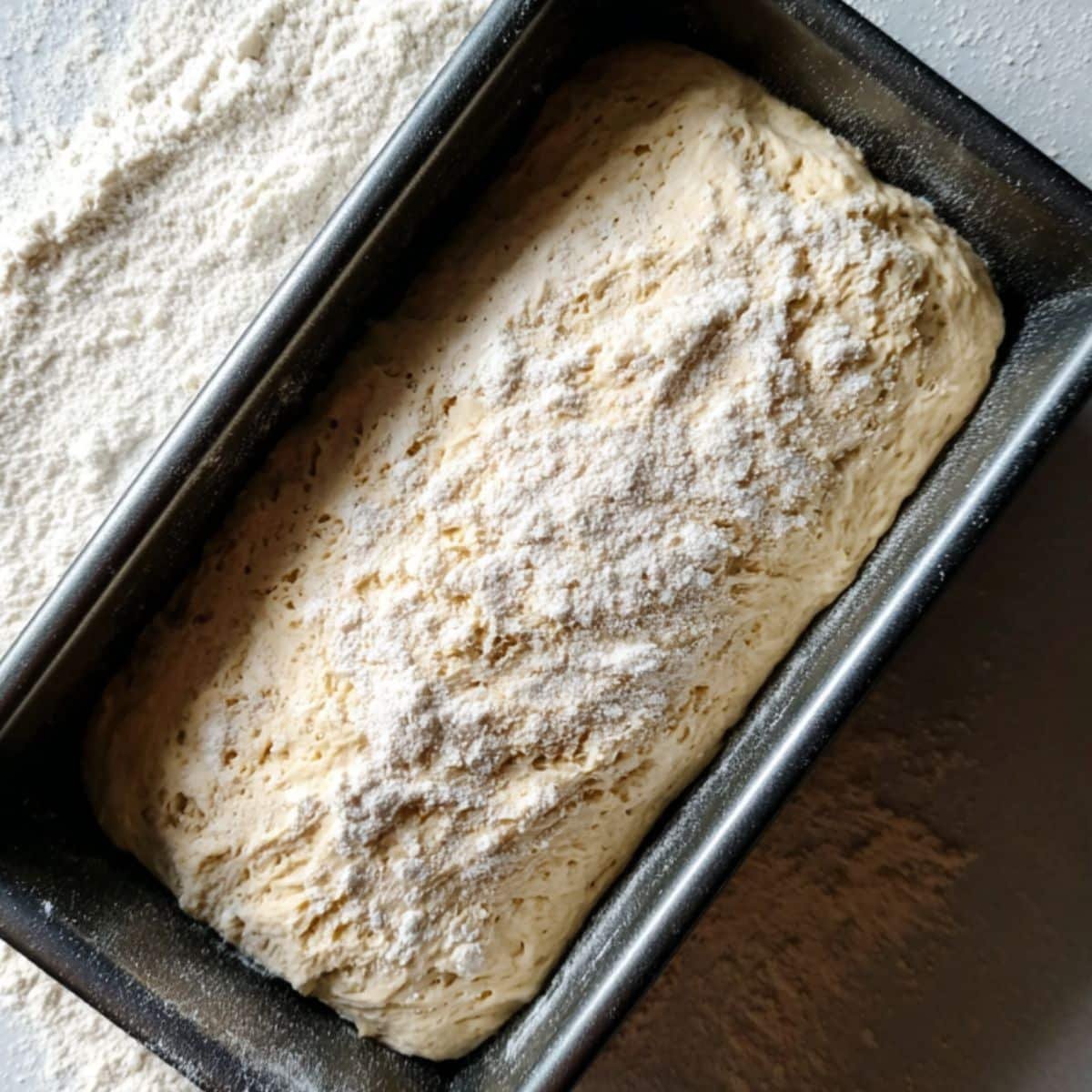
- Shape and Final Rise: Shaped dough in cornmeal-dusted loaf pan on white surface
Equipment For Sourdough English Muffin Bread
- Large mixing bowl
- Kitchen scale for accurate measurements
- 9x5 inch loaf pan
- Clean kitchen towels
- Bench scraper or spatula
- Wire cooling rack
Expert Cooking Tips
- Maintain your sourdough starter at peak activity for best rise and flavor development in your sourdough English muffin bread
- Use a kitchen scale rather than volume measurements for consistent results
- Test doneness with an instant-read thermometer; internal temperature should reach 200-205°F
- Score the top lightly before baking to control expansion and create an attractive appearance
- Cool completely before slicing to prevent gummy texture and allow proper crumb development
Recipe Variations
- Whole wheat version: substitute up to 30% of bread flour with whole wheat flour for added nutrition in your sourdough English muffin bread
- Herb and cheese blend: fold in dried herbs like rosemary or thyme with grated parmesan
- Sweet cinnamon swirl: add cinnamon and a touch of brown sugar for breakfast-worthy sweetness
- Seeds and grains: incorporate sunflower seeds, poppy seeds, or rolled oats for texture contrast
- Sourdough discard version: use unfed starter and add a pinch of commercial yeast for quicker results
Storage
- Room temperature: store wrapped in plastic or airtight container for up to 5 days
- Refrigerator storage: keeps fresh for up to 10 days when properly wrapped
- Freezer friendly: slice before freezing and store for up to 3 months in freezer bags
- Toast directly from frozen for convenience and optimal texture restoration
- Avoid storing your sourdough English muffin bread in direct sunlight or humid environments
Grandma's Secret That Changed Everything
The real magic behind exceptional sourdough English muffin bread lies in patience and understanding your starter's personality. Every sourdough starter behaves differently based on flour type, hydration level, and environmental conditions. I learned this lesson from my grandmother, who taught me to listen to the dough rather than slavishly follow timing charts. When your sourdough English muffin bread dough doubles in size and develops a slightly sweet, yeasty aroma with tangy undertones, it's ready for the next step.
Temperature control becomes your secret weapon for consistent results. Room temperature fluctuations can dramatically affect fermentation speed, so I always keep a thermometer nearby and adjust timing accordingly. During colder months, I place my rising dough near a warm oven or heating vent, while summer heat requires cooler spots to prevent over-fermentation. This attention to environmental factors transforms good sourdough English muffin bread into extraordinary loaves that rival any artisan bakery.
FAQ
Are sourdough English muffins better for you?
Yes, sourdough English muffins offer several health advantages over conventional versions. The fermentation process breaks down gluten proteins and reduces phytic acid, making nutrients more bioavailable and potentially easier to digest. The natural probiotics and lower glycemic index make sourdough English muffin bread a more nutritious choice for sustained energy levels.
Are there sourdough English muffins?
Absolutely! Traditional sourdough English muffins have been enjoyed for centuries, and this sourdough English muffin bread recipe captures those classic flavors in convenient loaf form. Many artisan bakeries specialize in authentic sourdough versions, and making them at home allows you to control ingredients and fermentation time for optimal flavor development and texture.
Why is my sourdough English muffin dough so sticky?
High hydration creates the characteristic open crumb structure in sourdough English muffin bread, so stickiness is normal and desirable. The dough should feel tacky but manageable when properly hydrated. If excessively sticky, your starter might be over-hydrated, or environmental humidity could be affecting flour absorption. Light flour dusting helps with handling without compromising texture.
Is sourdough healthier for you than regular bread?
Research suggests sourdough offers several health benefits compared to commercial yeast breads. The extended fermentation process pre-digests proteins and starches, potentially reducing digestive stress. Sourdough English muffin bread typically has a lower glycemic index, improved mineral absorption, and beneficial bacterial cultures that support gut health while delivering superior flavor complexity.
Expand Your Sourdough Journey
Now that you've mastered this incredible sourdough English muffin bread recipe, why not explore other delicious homemade treats? The Heavenly Strawberry Banana Bread Muffins offer a perfect sweet complement to your savory sourdough skills, combining fresh fruit flavors with tender, cake-like texture. These muffins make excellent breakfast companions alongside your freshly toasted sourdough English muffin bread slices.
For those seeking gluten-free options, the Easy Gluten-Free Cornbread Recipe provides another fantastic addition to your baking repertoire. This cornbread pairs beautifully with the tangy complexity of your sourdough English muffin bread, creating diverse meal options for family gatherings or solo breakfast indulgences. Both recipes complement the artisan spirit of sourdough baking while expanding your homemade bread collection with exciting new flavors and textures.
From my kitchen, with heart.
Emily Nelson ❤️
Related
Looking for other recipes like this? Try these:
Pairing
These are my favorite dishes to serve with English Muffin Bread

Sourdough English Muffin Bread
Equipment
- 1 Large mixing bowl For mixing and fermentation
- 1 Kitchen scale Accurate measurements
- 1 9x5" loaf pan For shaping and baking the dough
- 2 Kitchen towels For covering during rising
- 1 Bench scraper Helpful for shaping
- 1 Cooling rack To cool the bread post-bake
Ingredients
- 0.5 cup Active sourdough starter At peak activity
- 1.5 cups Warm water Around 90°F
- 1 tablespoon Honey or sugar For flavor and fermentation
- 3.5 cups Bread flour
- 1.5 teaspoon Salt
- 1 tablespoon Olive oil
- Cornmeal For dusting pan and top
Instructions
- Mix starter, water, and honey.
- Add flour and salt to form sticky dough.
- Cover and let rise overnight (8–12 hours).
- Dust loaf pan, shape dough, and place into pan.
- Rest dough for 2–3 hours until it crowns over the rim.
- Bake at 425°F for 35–40 minutes until golden and sounds hollow.













Leave a Reply